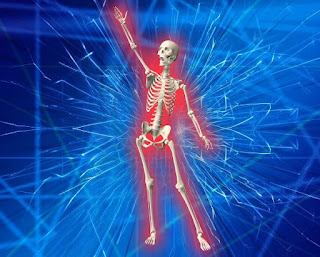The Talkative Bones Within
Last night I was talking with the skeletons in my huge walk-in closet, asking what would happen if someone discovered them. They just looked at me without answering. I gave up and closed the door. As I walked away, I heard them laughing.
A researcher with an appropriate name, Lynda F. Bonewald, was told not to waste her time studying one of the three main bone cell types, osteocytes, even though they are about ninety percent of bone tissue. Apparently osteocytes didn't have a known function, so ignore them. Good thing she ignored her advisors.
Okay, we all know that skeletons in the closet are not real except for use as props or classroom instruction. Actual skeletons do not talk. Interestingly, trees talk in their own way, and our bones have vitally important discussions inside us — through cellular communication.
 |
| Skeleton at the disco, Pixabay, background by Geralt, skeleton by Rachaelmarie, I also used cleanup.pictures |
Lynda showed scientific inquiry, and found that osteocytes are important in our internal conversations. (The attitude of ignoring is reminiscent of "vestigial" organs and "junk" DNA: They were not understood, therefore, unimportant.) If secular scientists and the medical profession realized that the Creator designed things with purposes in mind, they would have significantly more progress.
The human skeleton hanging in the classroom often gives the impression that bones are inanimate objects, only serving as a structural support for the body. However, in the last several decades, scientists have learned that the skeletal system is far more dynamic and complex than previously imagined.Scientists are now able to track signals between bones to other parts of the body. A Smithsonian publication explained these discoveries are like suddenly finding out “that the studs and rafters in your house were communicating with your toaster.” The more researchers continue to study the human body, the more they realize the organ systems are intrinsically linked through molecular conversations through receptors, signaling molecules, and transcriptional cascades. The intricate molecular language of biochemistry is elegant and reflects the unapproachable wisdom of our Creator.
The rest of the article is located at "Your Bones Talk."